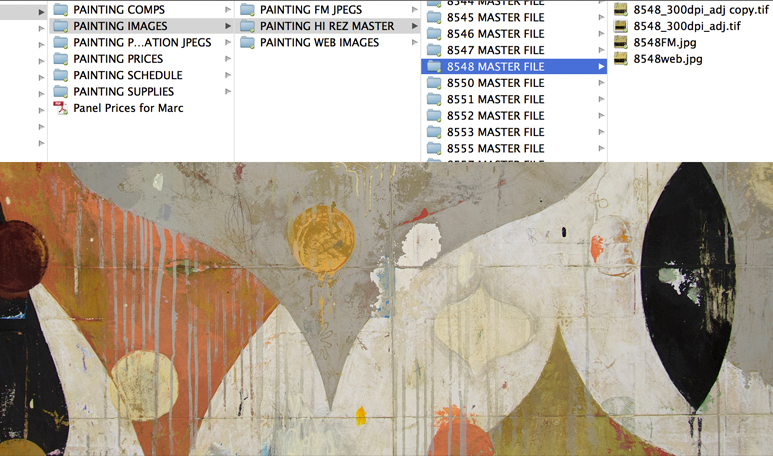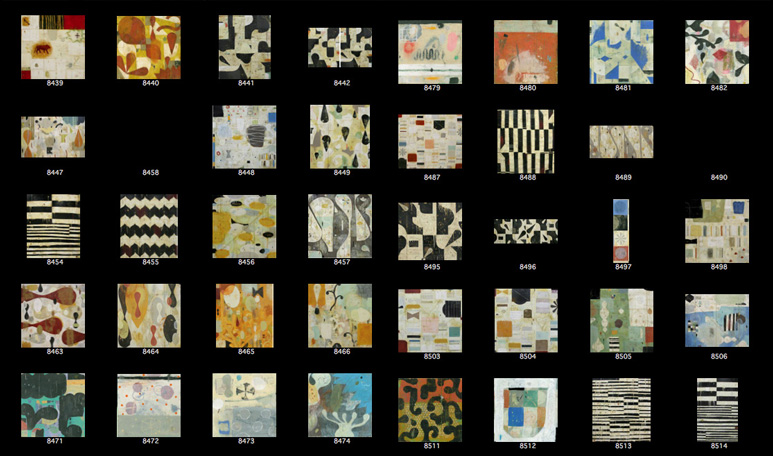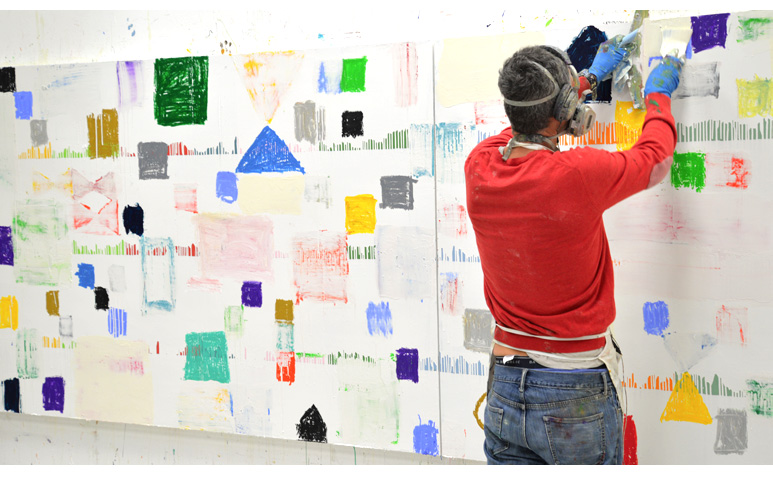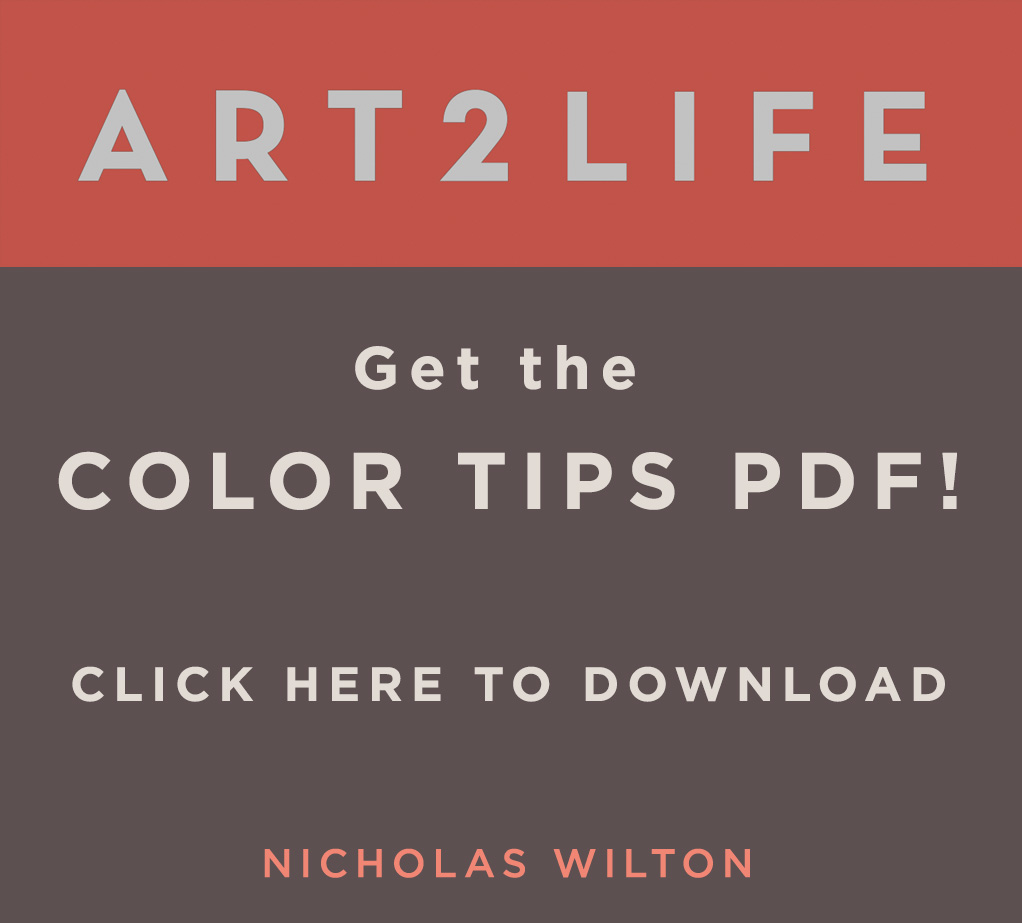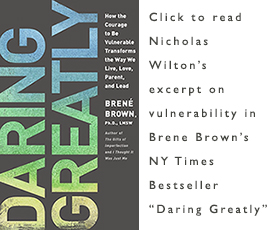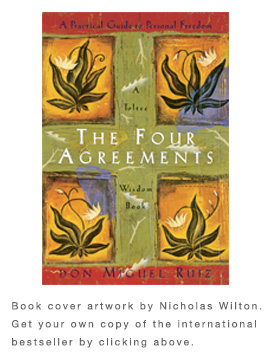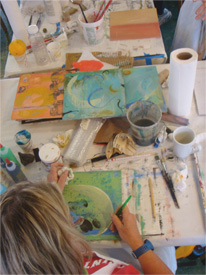Beginning When You Can’t See The End
 I have a hunch that I might be able to create some kind of art that is meaningful. I do not know what it is, nor do I admit this to anyone. I think about this for possibly years.
I have a hunch that I might be able to create some kind of art that is meaningful. I do not know what it is, nor do I admit this to anyone. I think about this for possibly years.
One day I try to do something in the smallest way possible, when nobody is looking. I keep the art supplies in a drawer.
I am unsure but find that it feels good to experiment with the art supplies. So I do it again. And then few more times.
I finally show someone what I have been making. They really love it and want to see more. Whenever I see this person they always ask about my Art. They tell a friend.
I continue making my Art. It is sporadic but over time it starts to become habitual. For a birthday gift, I give my favorite one to my closest friend. When everyone sees it I am not prepared for the attention it and then I receive. I feel elated and vulnerable at the same time. This Art is more me than I thought. It scares me a little.
Even so, I prefer making my Art to doing most things now. I start to look for ways to be more efficient. Finding a small corner where I can leave things set up makes a big difference.
Within a year I have moved into the garage. Even though it is cold at times, having the extra space is wonderful. I notice that as my space gets bigger so does my Art. When I was working yesterday with the roll up door open, my neighbor came by and loved what I was making. He ended up buying two. I didn’t know what to charge. He liked the two that I liked the best and even though I am sure I undercharged him, it felt so good to have someone besides me love my work.
It has been over a year now. I now have made so much Art that it feels OK to let it go. I do not need to keep everything I make. I am more interested in the Art I am making rather than the Art I made.
I am not sure where all this is going. I do know I feel more and more like myself. Sometimes I wake up in the middle of the night and find myself thinking about my Art. I can’t imagine not doing this now and I wonder where my Art will lead me in the coming years. I am so curious.
There is so much uncertainty about my Art and that can be hard sometimes. There are so many things I do not know yet.
I do know one thing, however. In fact, I am absolutely certain.
When I make my Art, I feel more alive.
In gratitude, Nicholas
HOW CONSISTENCY GIVES YOU MORE FOR LESS
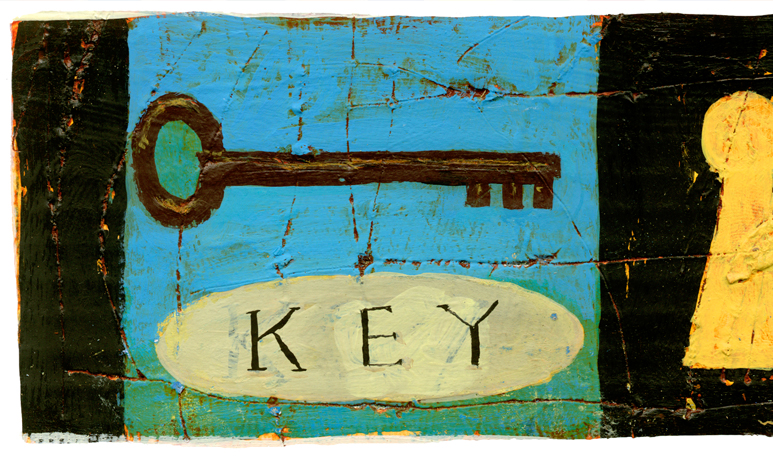 When I am out of the studio I become happily engrossed in my life. After only one day, however, I start to lose touch with what I was doing in my art practice. Sometimes if I am gone for too many days I even forget basic principles of Art that I teach in my workshops and classes. I actually have had to reread my course outlines to remember. In the end, what always refreshes my mind and gets me back on track is coming into the studio, sitting down and beginning to make my Art.
When I am out of the studio I become happily engrossed in my life. After only one day, however, I start to lose touch with what I was doing in my art practice. Sometimes if I am gone for too many days I even forget basic principles of Art that I teach in my workshops and classes. I actually have had to reread my course outlines to remember. In the end, what always refreshes my mind and gets me back on track is coming into the studio, sitting down and beginning to make my Art.
This realization illuminated, for me the most powerful and influencing agent of change in my Art practice: Consistency.
Understanding and incorporating the idea of consistency into my Art practice has dramatically shifted and improved my Art. It has also made the process of making Art more enjoyable. I simply stress out about it less now.
Here are some of the primary understandings around Consistency that have helped me the most.
1 Frequency is more important than duration.
One of my favorite books on creativity is David Bayles’ book “Art and Fear.” Bayles describes an experiment that was done in a college ceramic class. Half the class was graded on the number of pots produced over the semester and the other half of the class was assigned to make just one pot for the whole semester. In the end, surprisingly, by far the most amazing pots were created by the portion of the class that was being graded by the number, rather than the singular achievement of one pot. Frequency of effort, repeated process from start to finish in short periods of time allows the artist to work without the nagging pre occupation of results, but most importantly to more easily remember and stay connected to their own particular way of working. In this mode, Art is simply more easily generated. And often much of it is very strong.
Pay attention to by how often you work not how long you work. If you can only free up one day and you end up working all day on a Saturday, and then can’t return till the following Saturday, it can be easy to forget during your week what and where you were going when you were working. I find it better to show up, even if only for half an hour, several times a week. Of course you can still pull off the marathon sessions but try and add touchstone visits in between. Your work will really begin to move.
2 Self Doubt grows in absence.
Next time you feel uncertain about your Art, ask yourself when was the last time you actually made something?
I have found that I hit patches of self doubt when I am returning from a vacation or a business trip that has kept me out of the studio for 4-5 days. Oddly Xmas break is the worst for me. Trying to understand why you’re just not feeling it, or how exactly you could change your work never seems to yield any results.
The only thing that eventually does help is when you finally, finally start back in again. Within minutes of actually doing your practice, the feelings of uncertainty begin to lift. Clarity begins to return.
Of course we all come and go from our practices but it is helpful to remember that more often than not, clarity and ease are waiting for you as soon as you begin your practice. The answer is in the doing. And doing more frequently, even for shorter periods of time can yield amazing results. Next time you find yourself thinking about what might be the solution, stop and just begin doing your Art again. The answer is patiently waiting for you there.
3 Consistency creates consistency.
Consistency is not something that we are necessarily born with. It takes focus and resolve to repeatedly show up. I always have noticed the less you do the less you do and the more you do the more you do. In other words it takes a bit of concerted effort to put the trend of being consistent into place, but once it is, the benefits, the results are so rewarding that it almost becomes addicting. It just feeds your curiosity to see how this thing you are involved in, this personal pursuit of your own making, is going to turn out.
What will I possibly make today?
This curiosity, this momentum is fed by consistency. The potency of the Art you make today is absolutely derived and fortified from the arc of repeated efforts trailing behind you. The more of these efforts, the more visitations to your practice there are, regardless of how small, is what in the end will take your Art to that next level.
Put consistency in place, and then you can just let your Art naturally unfold. You will be amazed at what happens.
What has your experience with consistency been? Please leave your comments below so that we may learn from each other.
THREE WAYS TO GET RE INSPIRED ON YOUR ART
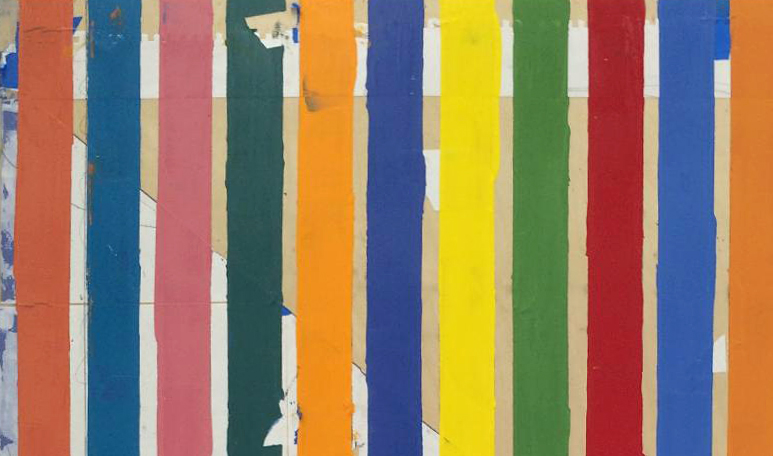 Sometimes you just lose momentum. Sometimes you look at everything you are making and it all feels flat. Sometimes you just don’t feel like going into the studio.
Sometimes you just lose momentum. Sometimes you look at everything you are making and it all feels flat. Sometimes you just don’t feel like going into the studio.
Here are 3 easy ways to get re inspired on your Art.
Your Art is your vacation.
I heard an amazing talk at World Domination Summit in Portland Oregon. It was by Bob Moore who founded Bob’s Red Mill grain company. At 85, Bob is still felt super excited about his career and he spent the better part of an hour offering us advice, not just about business but about life. (I recommend watching this video of his talk)
There was one thing he said regarding careers that I never forgot. In explaining how he could remain so passionate about his job, he smiled and said, “Your Vocation should be your Vacation.”
This resonated with me, but I also see that in real life, most typical jobs don’t have that flexibility. In Bob’s case it really helps to be the owner of the company.
It is important to remember that Art is not a typical vocation. A career in art contains within it an extremely valuable attribute. Art careers accommodate your necessity to change.
A career in art is utterly and totally flexible and adjustable to whatever it is that you want. This spaciousness is built in, but sometimes we forget we have it, especially when the only thing staring back at us is something we have toiled over to such an extent that we are just plain are sick of it.
Instead of thinking there is a problem with your vocation try thinking about how to change things so it feels more in alignment with you. It could be your materials, when and where you work and even what you make. Think about making things more like a vacation for yourself.
And less like a vocation.
Start something new
The feeling of being bogged down is usually based upon something that has been worked on too long. Things become stale. Boredom sets in. It takes enormous energy to overcome this empty feeling, to then re invigorate this work with something that can make it super dynamic again. So instead of trying so hard to overcome these emotions, try a different tact.
Put it aside and start something that is new. Preferably without a plan. Do something that feels easy.
Two essential components to be present within us to create potent art are curiosity and wonder. New beginnings always come with both. Starting something new returns us back into the kind of thinking and hopefulness that can generate our best work.
Easy is the New Hard
Do you sometimes find that your best work was also the easiest? I do. This happens to me all the time. Now when I am struggling for too long, I literally choose to stop.
After a break I promise myself that I will only proceed with actions that feel like a “yes”. I then try and stay in the groove of what is easy instead of hard. After all, most of the work of others that I admire looks more effortless than effortful.
I believe that effortless can only be learned by practice. This little shift in the way I work has helped me significantly. Why should it always be so hard?
Give yourself a break and once again return to what brings you a joyful yes. Everyone will be happier, especially you.
How do you make your Vocation more like a Vacation? Please leave your comments below.
HOW TO SIMPLY KEEP YOUR ART ORGANZIED – PART TWO
Last week in a prior blog post I explained several helpful benefits to using unique four digit ID#s to label your art. Here are 3 more.
Finding, Seeing and Naming Digital Files Better
When you nest dozens of folders all named with unique ID#s on your hard drive, your computer will automatically order them sequentially. This is a tremendous help. Having your artwork arranged in a folder in the order it was made allows you to clearly see and find and piece of art you have made, even if it was 3 years ago.
It is crucial to always include the ID# in the file name of your image.
Here is how I name my folders:
I have one folder called Master Images. Within this folder I have dozens of folders, 4001 Master File, 4002 Master File, 4003 Master File, etc. Within each of these folders I keep all derivations of that image.
For example, I will have 4000.raw, this is the biggest unadjusted file I have of the image. 4000_adj.tif is the biggest adjusted file I have, 4000_10x10_300dpi.tif is a reproduction file I might have created. 4000_web.jpg is what I use on the web.
Of course you can name any file your own particular way, but the important thing is that ALL variations of that image are in one folder, one place and easily found.
Makes it easier for someone to help you.
This might be the primary reason you want to start codifying your creative journey with ID#s. Being able to hand someone a list of 57 paintings with instructions to modify or email 26 of them to two different places is very easy if all these artworks are listed numerically. Want to have your assistant take down 7 images and put up 4 in a specific number on your website? The instructions for this potentially confusing task can be done with image ID#s on a post it note. You might get an email from a collector or a gallery who are asking for a high-resolution file of a certain blue painting. You might remember which painting this is, but if someone is helping you they soon learn to simply ask for the ID# right below the painting on the website. Once verified they can feel confident finding it on the computer and then can email it. Not only was this task done quickly and correctly but more importantly it was done without involving you.
Understand your Creative Arc Better
When I get stuck or disillusioned with my Art, I find it incredibly helpful to go back in time and look at everything I have made in the past couple of years. The automatic ordering of image numbers in folders makes this super easy.
Being able to go through the past 3 years of my artwork in the order it was made in about 10 minutes is unbelievably informing. It is the momentum, the trail of finished work that has been left behind you that forecasts, informs where you are heading. The visual history of your creative past is your unique touchstone. It silently champions your individuality, your hard won authenticity. It is a key component to making amazing potent work in the future.
It also doesn’t take long for me to start appreciating and really seeing how far I have come, how much my work has improved and to re remember my inspiration.
There are way too many negative forces that lower our energy or expectations about what we are creatively capable of accomplishing. Therefore, it is essential to set in place as many systems or practices that can clarify and re galvanize our artistic resolve. Being organized so that you can gain objectivity of your entire creative arc over time is one of them.
Organizing my artwork using ID#s, in addition to titling, has dramatically saved me time and has helped keep my momentum going. I hope there are aspects of this idea that you can utilize for your career too.
What are some of the ways that you keep your Artwork organized? Please leave your comments below so we can learn from each other.
HOW TO SIMPLY KEEP YOUR ART ORGANIZED – PART ONE
Do you find it difficult to keep track of all your art that you have made over the years? Do you forget when you made what? Or which gallery has what? Or even worse, where your Art actually is?
This used to happen to me.
Until I started giving every piece of art I made an image number. What started out as just a little simple idea turned into one of the major contributing factors that has allowed me to thrive as a fine artist.
I am going to cover this important topic in detail in my next two blog posts.
Here is Part One:
The Concept:
I assign a four digit unique ID # to every piece of art I make. The numbering is sequential. I began with #0001 when I graduated from Art Center College of Design. I am now at #3,743.
This number is always written on the back of my actual artwork along with my name, title, size, date, materials and website. As an aside, just let me stress that the most important piece of information of all 7 is your website. In addition, this same 7 lines of information should also be entered in a database, an excel file or any other word processing file you are familiar with. I use File Maker.
Having a digital sequential record of all your artwork saves you countless hours of time. It is here that you would record dates of when a painting was sent to a gallery, where or to whom it was sold, etc. What is important is that your art becomes traceable and filed by it’s unique image number.
Using ID#s are very, very helpful. Here are the first of three primary benefits to using a sequential ID numbering system for your artwork:
#1 Never lose your artwork on your computer.
It is helpful to think of this number as a second title to your work. Like your social security number, it will always be listed with your artwork. This ID# is shorter than the actual title, totally unique and also informs you chronologically when it was made. This four digit number should be included in the naming of it’s digital photos, jpegs, high rez scans etc. on your computer, all stored in the same folder using this same ID #.
Your computer’s search feature (command F) loves unique 4 digit numbers and will instantly tell you how many iterations of that particular art exist and exactly where they are on your computer. When you nest dozens of folders all named with unique ID#s in a folder on your hard drive, your computer will order them sequentially automatically. This is a tremendous help in keeping folders of many images organized. Being able to easily and instantly find your artwork can save you countless hours of time.
I even list this number alongside all of my website images. so that if someone is interested in 5 paintings, I can ask them for these little ID #s and immediately pull them up on my computer or send them jpegs or high rez scans.
The ID#s are short and so when image files of a particular painting are attached to an email they can easily be seen and verified that they are in fact attached.
Later this week I will be posting the second part of How to Simply Organize your Artwork which covers how using image ID #s makes it easier to stay buoyant in your practice and freeing up more time to spend making your Art.
I am very curious as to how you handle the organization of your artwork. Please leave your comments below so that all of us can possibly learn more.
HOW TO FEEL HAPPIER ABOUT YOUR ART
 “Yellow” by Nathan Sawaya
“Yellow” by Nathan Sawaya
I admit it. Sometimes, when my own Art frustrates me, I compare it to other artist’s work. So many artists seem so much further along than me. Their work is stronger, they are more successful, and they all seem to have better galleries. Maybe if I tried to make my work more like theirs, I too would be more successful, more saleable, and happier.
I know I am not alone in sometimes having these feelings.
Interestingly, when you are thinking in this way, it never makes you feel any better. It is almost a way of distracting yourself from doing the actual work of making your work better. It rarely helps you improve your work because you are actually not even thinking about your art. You are thinking about someone elses.
Here are several ways of thinking about your art/career so that you will feel happier.
AUTHENTICITY IS KING.
Accepting your work, no matter what stage it is in, is ultimately a reflection of your own self-acceptance. There is no single, more potent approach to making amazing work than trusting you own originality. Those who refocus their awareness more on what they are creating, instead of what everyone else is making, will generate art that is more personal, and as a result, more unique. Pay attention to what you are doing and what feels right to you. Everything you need to make amazing, breath-taking work is already within you. It is just a matter of giving it the attention and focus it needs to become visible. And that success we all imagine? Another word for that is Authenticity. They are one and the same.
DON’T SKIP STEPS.
There are many steps in the process of becoming a successful artist. Making something you genuinely like is possibly one of them. Maybe selling or giving your art to someone who recognizes your value is one too. Galleries, teaching others, breakthroughs in the middle of the night, inspirations…there are countless incremental steps that will lead you to the creative success you desire. Each successful step taken should be celebrated and savored. Each step informs the next. You wouldn’t want to miss any of them. There is a logical order to your unfolding as an artist. It is not possible, even if you could, to jump ahead to a step without taking all the previous ones. Every artist before you has taken most of them. If you are solidly in this step-by-step process then you are already being successful.
OTHER ARTISTS’ SUCCESSES ARE YOURS TOO.
We are not involved in making widgets. We are not involved in figuring out a way to perfectly repeat ourselves. We are making Art. And yes, it is harder than merely perfecting one thing, one time. Thankfully, there are other artists who have gone before, who have achieved what we too would like to achieve. Do not let the success of others limit your happiness. We need others to succeed, to confirm again and again, to demonstrate the promise that exists within us all.
Another artist’s success merely collectively adds to the inevitability of our own. We just must be willing to savor and celebrate each of the sequential natural steps in our own journeys.
These three ideas have helped me when my work isn’t going so well.
How do you think about your Art when you are struggling with it?
To subscribe to my blog and monthly newsletter, please click here.
3 WAYS TO MAKE YOUR ART BIGGER AND BETTER
When you make a mediocre painting bigger it just gets more mediocre. I sure know this feeling and I don’t like it. However when you make something powerful AND it happens to be bigger then it can become breathtaking. Making art bigger than ourselves can be challenging. But it doesn’t have to be.
Here are three easy ways to make your Art bigger and better.
#1 MAKE THE CLOSE UP VIEW AS STRONG AS THE DISTANT VIEW
When art that is bigger than yourself, it is important that the art looks exciting, not just from close up, but also from across the room. Sometimes when our Art is large, we stand right up close and get lost in all its detail. However, from a distance the viewer can’t see these subtleties. If it doesn’t look interesting from a distance then no one will spend the time walking across the room to look at it. A strong work of art needs amazing detail, subtlety (close up view) juxtaposed with bold, loud composition or interest that can be seen from far away (Distant view.) Both aspects need to be equally strong.
This idea can be easily seen in Georgia O Keefe’s painting “Horses Skull with Rose”
I like to think of how my art would look to someone driving by a gallery in a car traveling at 25 mph. If, that one second, distant view is compelling, then and only then will the driver pull over and come into the gallery to have a look at my work.
#2 SCALE UP YOUR TOOLS AND MARKS
When the work gets bigger, then so should the tools used to make that work. Imagine a 1” brush being used on a 12” square painting. The brush relative to the size of the art is quite large. Now if you make that 12” square painting 72” x 72” square, it has grown in scale 36 times! Taking a brush only slightly bigger, say 2” will in no way be enough to generate a similar powerful brushy feeling of the 12” painting. Basically, going larger with your tools will help you scale up the feeling you achieved in the smaller work. I was amazed at the scale of tools Gerhard Richter used to produce his amazing “Cage Paintings”
Also, what might be a bold gesture, done with a twist of the wrist on a smaller work might not be enough once the work becomes larger. Your emotion and the physical movement of mark making have to also grow in scale to pull off larger work. Larger tools will help you achieve larger work.
#3 MAKE YOUR THINKING BIGGER
When working on your Art, especially something at scale, it is important that you push yourself to think beyond the confines of the edges of your actual Art. Imagine that your art is merely a window into something bigger. Imagine you are creating a cropping of something that is bigger as you work. A shape that is made while worrying about the actual boundary of the art will feel small and self-conscious compared to one that ignores or is not aware of the physical edges of the Art.
Sometimes I like to start my painting outside the panel I am working on. It invariably makes a more powerful statement. Large work doesn’t work if your thinking remains the same as when you were working on something small.
Be expansive in all ways so that your art will not just look large but will feel large as well. It needs to be both.
These are some of the ways that have helped me work larger. What ways or thoughts do you use to make your Art bigger? Please comment below.
HOW TO SHIFT YOUR ART FROM GOOD TO GREAT
 Michelangelo’s “David”
Michelangelo’s “David”
I think you know when something you have made surpasses Good and becomes Great. I know I do. It feels wonderful. Unfortunately, this doesn’t happen all the time. How can you shift your work from Good to Great more often?
The answer is very simple:
Just say NO! to Good.
Literally, say it out loud—in fact, tell your merely Good art you want it Great!
Don’t you already have enough mediocre work hanging around your studio taking up space? I sure do. Who needs more of those? Don’t settle for Good. If you develop a habit of refusing Good, then you can work on your art more freely because it is no longer precious. Treat it like the pesky poser of Great that it is and go for it with all your creative force. Kick it to the curb. Remake it into something Great.
Again, the answer is about setting a strong intention. Don’t be reserved in what you truly desire. If you are not crystal clear with your communication with yourself, the universe will just presume that merely Good is enough.
Tell the world what you want. Tell the world you want it Great!
And then, and only then, it can possibly become so.
Setting intentions for myself has worked miraculously. Has this ever been your experience? Please comment below.
With confidence, Nicholas
THE WORLD WILL DESIRE YOUR ART IF IT IS LIKE YOU
 Detail from “Arcade” by Nicholas Wilton
Detail from “Arcade” by Nicholas Wilton
People desire art because it makes them feel alive. Like leaving a monotonous office job for a vacation, Art gives people a new, fresh experience that they crave. The Art that we notice, talk about and dream of does this really, really well.
The primary reason is because it is different from things we have all seen before. Great art is great for this very reason.
So how do we make Art that is truly different?
The answer cannot be found in books or even on the Internet. It certainly cannot be discovered in other artist’s work, although sometimes it appears so. The answer is the same one I use to explain to everyone I teach who doubt their own creative abilities.
The answer is based on two facts.
Fact #1:
Each of us is utterly and totally unique.
Fact #2:
If we make our Art more like ourselves, it will be utterly and totally unique.
That’s it. Plain and simple. No one is excluded. There are no special people with gifts ordained from above as much as some of us would like to believe. The creative pursuit is available to anyone. All that is needed is the desire and curiosity to make and develop work that feels more and more like yourself.
If you do this, your work will be utterly unique. And then, and only then, will the World desire your work.
In fact, they will crave it.
Think of some of your best work. Is it so because it was something new you hadn’t seen before? What was the response? Please leave your comments below.
Encouragingly, Nicholas
HOW TO TITLE YOUR ART SO IT SELLS
 “Tomboy” by Nicholas Wilton.
“Tomboy” by Nicholas Wilton.
When someone is about to purchase your art they always look at it for a long time. They also look at the small white tag on the wall next to the art to see the title. They are looking for connection with your art. How the work looks offers the primary point of connection for the buyer. The title of the work, however, can also provide another point of connection for a buyer who is undecided, to then go ahead and purchase your work.
Here are 3 key ideas to remember when creating titles that can help sell your art.
1 Don’t be redundant.
Do not try to restate exactly what the painting is already communicating. Think of the title as an additional part of the art that provides something new. For example if you paint a picture of a dog growling at a passerby and you call it “The Mean Dog” then basically both the art and the title are saying the same thing. Instead, choose a title that is more different than your art, not less. You want the title of your artwork to offer a new experience that is refreshingly different.
2 Connect the feeling of the Art to the title
Instead of a title that is a literal retelling of your art, identify the key feeling you experience or want to convey. Then choose words or phrases for a title that conjure up those same feelings in you. For example if your art is showing green grass against a blue sky, instead of the title being “grass” it could be “breeze” which could relate to the feeling of lying in tall grass on a spring day and how that feels. “Breeze” gives the viewer something new in addition to green grass. You just doubled the chance that someone will connect with your art.
3 Make your Title Expansive.
You want the title of your artwork, whether it is literal or abstract, to be as encompassing and expansive as possible. If the title is expansive then there is room for the viewer to have their own interpretation. For example, if your painting is a series of red shapes, instead of titling it “Red Shapes” you called it “Crimson Storm” then most likely there will be more room for interpretation in the second name. Allowing others to find their own meaning in your work is not just generous, but also increases the likelihood that someone will personally interpret and then, as a result, purchase your Art.
Have you found that great titles help sell your Art? Please leave your comments below.
With encouragement, Nicholas
If you would like to subscribe to my blog and monthly newsletter, please click here.
